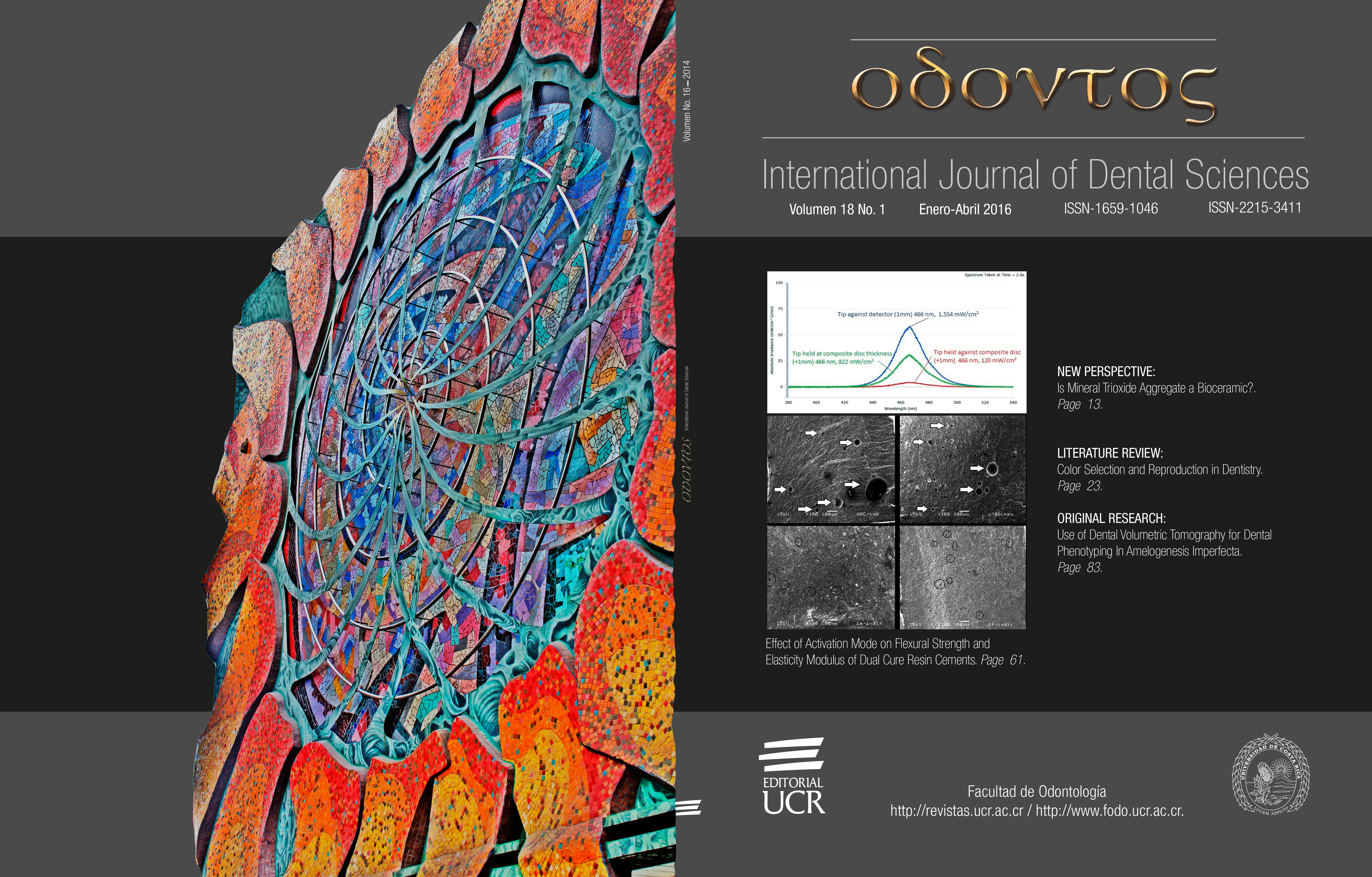Abstract
The purpose of this review is to provide the fundamental information for the early diagnosis of temporomandibular disorders (TMD) in children and adolescents, taking in account that the general trend among Dentists is to believe that these kind of disorders do not occur in the pediatric patient, or that they are present very rarely. However, this is not true; therefore, it is mandatory that, during the comprehensive clinical exam of the pediatric patient, a meticulous evaluation of the developing temporomandibular joint is included. The present paper pretends to serve as encourage interested to general and specialist Dentists on this important issue, and capable to advise, guide or treat their own patients, particularly young children; these patients cannot often communicate sufficiently their symptoms, because of their immaturity. Thus, only through a full exam, temporomandibular disturbances can be properly assessed, diagnosed and treated.
References
Casanova J., Medina C., Vallejos A., Casanova A. Prevalence and associated factors for temporomandibular disorders in a group of Mexican adolescents and youth adults. Clin Oral Invest. 2005; 10(1):42-9.
Resche L. Critical Reviews in Oral Biology & Medicine. 1997. (Accesado 13 de diciembre 2015). Disponible en: http://cro.sagepub.com/content/8/3/291
Figueredo L., Arango D., Grau I., Cabo R. Disfunción temporomandibular en la adolescencia tardía. Revista Cubana de Estomatología. 2012; 49(3): 204-214.
Campos M., Herrera A., Ruan V. Desórdenes temporomandibulares en la población infantil. Un tema Controversial - revisión bibliográfica. Revista Latinoamericana de Ortodoncia y Odontopediatría. 2006; (Accesado 16 de diciembre 2015). Disponible en: http://www.ortodoncia.ws/publicaciones/2006/desordenes_temporomandibulares_poblacion_infantil.asp
Sandoval I., Ibarra N., Flores G., Marinkovik K., Díaz W., Romo F. Prevalence of Temporomandibular disorders Accordin to RDC/TMDEE in older people of Santiago, Chile. International Journal of Odontostomatology. 2015; 9(1):73-78.
Krogstad B., Dahl B.L., Echersberg T., & Ogaard B. Sex differences in signs and symptoms from masticatory and other muscles in 19 years old individuals. J. Oral Rehabilitation. 1992; 19:435-40.
List T., Axelsson S., Leijon G. Pharmacologic interventions in the treatment of temporomandibular disorders, atypical facial pain, and burning mouth syndrome. A qualitative systematic review. J Orofac Pain. 2003; 17:301-10.
Magnusson T., Egermarki I, Carlsson GE. A prospective investigation over two decades on signs and symptoms of temporomandibular disorders and associated variables. A final summary. Acta Odontol Scand. 2005;63(2):99-109.
Corsini S., Fuentes R., Bustos L., Borie E., Navarrete A., Fulgeri B. Determinación de los signos y síntomas de los trastornos Temporomandibulares en estudiantes de 13 a 18 años de un colegio de la comuna de Temuco, Chile. Int. J. Morphol. 2005; 23(4):345-352.
Larrucea C., Castro R., Vera A. Prevalence of signs and symtoms of temporomandibular disorders in an adult population of Talca, Chile. Revista Dental de Chile. 2002; 93(3):28-36.
Guideline on Adquired Temporomandibular Disorders in Infants, Children and Adolescents.American Academy of Pediatric Dentistry (AAPD). 2015. (Accesado 10 de enero 2016). Disponible en: http://www.aapd.org/media/Policies_Guidelines/G_TMD.pdf
Bhat S. Etiology of Temporomandibular Disorders: the journey so far. International Dentistry Sa. 2010; 128(4):88-92.
Bonjardim M., Duarte M., Perira A. Mandibular movements in children with and without signs and symptoms of temporomandibular disorders. J. Appl Oral Sci. 2004; 12(1):39-44.
Barone A., Sbordone L., Ramaglia L. Craneomandibular disorders and orthodontic treatment need in children. J. Rehabilitation. 1997; 24:2-7.
Tuerlings V., Lime M. The prevalence of temporomandibular joint dysfunction in the mixed dentition. Europ J Orthodont. 2004; 26:311-20.
Zanandréa B., Magalhaes A., De Felicio C. Mandibular movements range in children. Pro-Fono Rev Atual Cient. 2009; 21:189-94.
Moyaho A., Lara C., Espinoza I., Etchegoyen G. Prevalence of signs and symptoms of temporomandibular disorders in children in the state of Puebla, México, evaluated with the research diagnosos criteria for temporomandibular disorders (RDC/TTM). Acta Odontol LatinoAm. 2010; 23(3):228-33.
Chávez C., Martins H., Melo L., Siriani B. Comparison between the reliability levels of manual palpation and preassure pain threshold in children who reported orofacial pain. Man Ther. 2010; 15:508-12.
Cortese S., Oliver I. Determination of range of mandibular movements in children without temporomandibular disorders. J of Craneomandibular Practice. 2007; 25: 200-5.
Ingervall B. Range of movement of mandible in children. Scand J Dent Res. 1970; 78:311-22.
Egermark, I. Mandibular dysfunction in children and individuals with dual bite. Swed Dent J. 1982; Supl.10.
Castro A., Pedron O., De Lima R., Rodriguez M. Examination of temporomandibular disorders in the orthodontic patient: a clinical guide. J Appl Oral Sci. 2007; 15(1):77-82.
Dworkin S. Reliability,validity,and clinical utility of the research diagnostic criteris for trmporomandibular disorders axis II scale: Depression, non-specific physical symptoms, and graded chronic pain. J Oralfacial Pain. 2002; 16:207-2.
Wahlund K. Temporomandibular disorders in children and adolescents: Reliability of a questionnaire, clinical examination and diagnosis. J Oralfacial Pain. 1998; 12(1):42-51.
Schiffman E., et al. The Research Riagnostic Criteria for Temporomandibular Disorders: Overview and methodology for assessment of validity. J Oralfacial Pain. 2010; 24(1):7-24.
Bodner L., Miller V. Temporomandibular joint dysfunction in children: Evaluation of treatment. Int J of Pediatric Otorhinolaringology. 1988; 44:133-37.
Medlicott M., Harris E. A systematic review of the effectiveness of exercise, manual therapy, electrotherapy, relaxation training and biofeedback in the management of temporomandibular disorder. Physical Therapy. 2006; 86(7):955-73.
Dym H., Israel H. Diagnosis and treatment of temporomandibular disorders. Dent Clin N Am. 2012; 56:149-61.
Wahlund K., List T., Larsson B. Treatment of temporomandibular disorders among adolescents: a comparison between occlusal appliance, relaxation training and brief information. Acta Odont Scandinavica. 2003; 61:203-11.
Koh H., Robinson P. Occlusal adjustment for training and preventing temporomandibular joint disorders. Cochrane Database Syst Rev. 2003; (1):CD003812.
Luther F., Leyton S., Mcdonald F. Orthodontics for treating temporomandibular joint (TMJ) disorders. Cochrane Database Syst Rev. 2010; (7):CD006541.
Muhtarooullary F., Demirel S. Temporomandibular disorders in Turkish children with mixed and primary dentition: Prevalence of signs and symptoms.The Turkish Journal of Pediatrics. 2004; 46:159-63.

